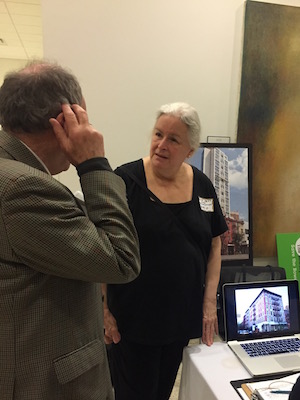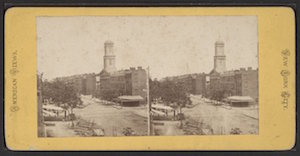
Preservation and Affordable Housing
New York City, home to ever-increasing housing costs, is becoming largely unaffordable to all but the very rich. Most people agree that an ample supply of affordable housing is important, because it allows New Yorkers to stay in their homes and helps ensure the diversity that is our city’s hallmark. The alternative is increasing gentrification and homogeneity.
The mayor has stated that the creation of new and maintenance of existing affordable housing is one of his administration’s top goals. His answer to the affordable housing crisis is a massive up-zoning of the city, under his ZQA rezoning proposal to be voted on by City Council this month.
The Real Estate Board of NY (REBNY) has used this campaign as an excuse to not only call for upzoning the city under the ZQA Act, but for halting the landmark designation of our historic neighborhoods. Landmark designation is the only viable tool to protect our historic buildings and streetscapes from demolition or unsympathetic alteration. REBNY claims that landmark designation causes gentrification and displaces long-time residents.
U.S. Census data reveals that blaming historic districts for gentrification is not based on fact, but on misinformation. As compiled by the Historic Districts Council (HDC), the census data show that from 1970-2010:
– Rental prices did not increase significantly more in historic districts than non-designated neighborhoods.
– In Manhattan, historic districts showed a similar increase in average median household income as non-designated neighborhoods.
– The percentage of households considered rent-burdened (paying more
than 35% of their income on rent) did not change at a significantly
different rate within historic districts than outside of them.
Additionally:
– Historic district designation has not prevented subsidized
housing from being built: subsidized housing was created at a higher
rate within Manhattan historic districts than outside of them.
– The percentage of existing subsidized housing in Manhattan was
maintained at virtually the same rate within and outside of
historic districts.
Meanwhile, REBNY continues to rail against landmarking and push for ZQA, in the interest of those real estate developers who seek only bigger, more luxurious buildings and more gigantic profits, unrestrained by community input or need. Should we give over our historic neighborhoods to developers, many of whom have no ties to or consideration of our communities?

Please contact your local Council member HERE and let them know that you are opposed to ZQA, and that any upzoning should be done on a neighborhood-by-neighborhood basis. For a sample letter see HERE and scroll down to LESPI’s June 9 letter.
HDC’s March 5 conference on preservation and affordable housing, Preservation and the Progressive Agenda was attended by LESPI Board members, who took in a wealth of information on the subject. On the same day they also partook in HDC’s Preservation Fair, where they exchanged preservation strategies and notes with other NYC local preservation groups.

LESPI T-shirts!
With spring just around the corner (some claim it’s already here), short sleeves are in order: LESPI t-shirts look great and show your support for East Village / Lower East Side preservation! Proceeds benefit LESPI’s work. Only $20 + S&H.; You can purchase t-shirts HERE

Join LESPI for 2016!
Your $20 membership dues help us work to preserve the historic East Village / Lower East Side. Or donate more: all donations are tax deductible as allowed by law. See HERE to donate. Thank you!
Support LESPI!
Donate!
Please donate to LESPI to help us in our work to preserve the historic East Village / Lower East Side! To donate, see HERE.
Or you can write a check to “FCNY/LESPI” and mail it to LESPI, c/o Neighborhood Preservation Center, 232 East 11th Street, New York, NY 10003. All donations are tax deductible as allowed by law.
Volunteer!
We’re looking for people to help with outreach, people with specialized skills and experience, monetary donations, and any other assistance that can help further our mission. We’d very much appreciate your help in our campaign to preserve the East Village / Lower East Side and hope to hear from you in the near future. Contact us at info@lespi-nyc.org.
Stay in Touch!
Go to “Lower East Side Preservation Initiative” on Facebook and check out our site! If you click the “Like” button you’ll receive periodic preservation, history and architectural updates for the LES/EV. You’ll also be showing support for our cause!

PRESERVATION UPDATE:
2 Oliver Street and 138 Second Avenue
For those of you following the travails of 2 Oliver Street (1822) and 138 Second Avenue (1832), recently heard at Public Hearing during NYC Landmarks Preservation Commission’s (LPC) review of backlogged potential landmarks (see LESPI’s October 28 letters to LPC HERE), we have disappointing news to report. In late February the Commission decided not to landmark these two properties, which had been calendared for Individual Landmark designation by the LPC many years ago, despite their long history and intact condition.

We are following up with LPC and our sister preservation organizations to determine next steps in seeking to save these buildings, and will keep you posted.
LESPI’S “New Design in our Historic Neighborhoods”

Most of us have experienced – probably many times – the “Look at that monster!” reaction to the latest massive, out-of-context building sprouting up on New York’s historic streets. Although we at LESPI are very supportive of new, sensitively designed buildings, including those built in an unabashedly modern style, we’re opposed to architecturally undistinguished, out-of-scale new buildings that seem to turn their backs on their surrounding neighborhoods. So how exactly are we to judge new buildings? What differentiates “monsters” from future landmarks?
To help crystallize our thinking on this subject, we invited Alex Herrera, Director of the NY Landmarks Conservancy’s Technical Services Center and previously Director of the NYC Landmarks Preservation Commission’s (LPC) Preservation Department, to speak to LESPI members and supporters about new design in historic neighborhoods, including such topics as the challenges architects face in contextual design, and what the LPC looks for in reviewing proposed new buildings.
Alex’s beautifully illustrated presentation demonstrated how new buildings should be judged aesthetically in the context of an historic streetscape: such characteristics as scale, massing, facade “texture”, materials and details can create a dialogue between old and new buildings. He noted that that the LPC, which regulates the design of new buildings and additions to existing buildings in historic districts, allows a wide range of approaches to contextual design: anything from replicating existing design and details to creating an original aesthetic that speaks to our present culture. However one thing that LPC insists on is a well thought-out design that they consider to be an architectural asset, rather than detriment, to the historic district.
Following Alex’s talk, attendees chatted over wine and cheese, comparing notes on their “loves and hates” of the many new buildings around town.
SAVE THE DATE – May 18!
Save the Date: on May 18 Lower East Side Preservation Initiative is sponsoring “Mom-and-Pop Storefronts and the Art of Vernacular Design: NYC’s Lower East Side and Chinatown”.
The event will feature speakers Thomas Rinaldi, author of New York Neon, and James and Karla Murray, authors of Store Front II: A History Preserved, New York Nights, and Store Front: The Disappearing Face of New York. Their illustrated lectures will explore the history and aesthetics of mom-and-pop signage and storefronts in these most iconic neighborhoods.
Invites will be sent out shortly to our LESPI mailing list: if you’re not on our mailing list and you’re interested in receiving an email invite, let us know at info@LESPI-nyc.org.
East Village: Lens on the Lower East Side
“East Village: Lens on the Lower East Side,” now in its third printing, is a wonderful compilation of contemporary photographs by photographers whose professional roots are in the East Village, and a beautifully written history by author Marilyn Appleberg.
Photographs by Don Freeman, Alan Gastelum, George Hirose, Onno de
Jong, Marlis Momber, and Ciaran Tully show that the historic East
Village is a vital, modern community, where the historic architecture
and beautiful, century-old streetscapes foster creativity,
self-expression and joy, as well as a diversity of people, businesses
and institutions.

Available at Strand, and The Source.
About LESPI
LESPI is a grass roots, all-volunteer 501(c)(3) not-for-profit corporation in NY State formed in 2007 to urge the NYC Landmarks Preservation Commission to designate as historic districts intact portions of the East Village / Lower East Side. Our strategy includes documenting and mapping the historic streetscapes, starting with the East Village, Lower East Side below Houston Street, and Chinatown, and rallying community residents, city officials and the LPC to effect landmark designation. LESPI is a not-for-profit corporation in the State of New York. Our fiscal sponsor is Fund for the City of New York.
Contact us by email at info@lespi-nyc.org, or use the form through our web site lespi-nyc.org, or by mail at LESPI, c/o Neighborhood Preservation Center, 232 East 11th Street, New York, NY 10003.